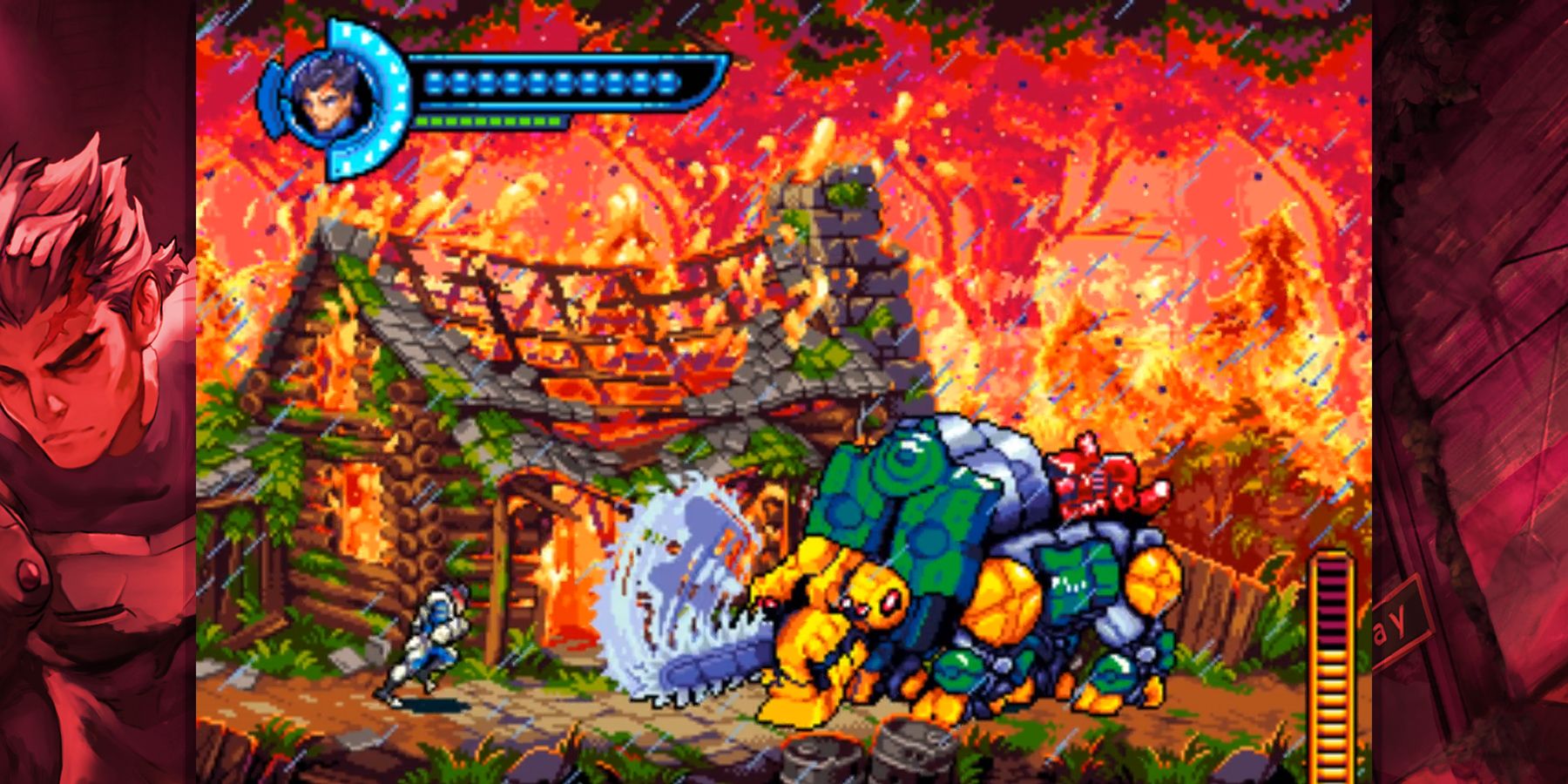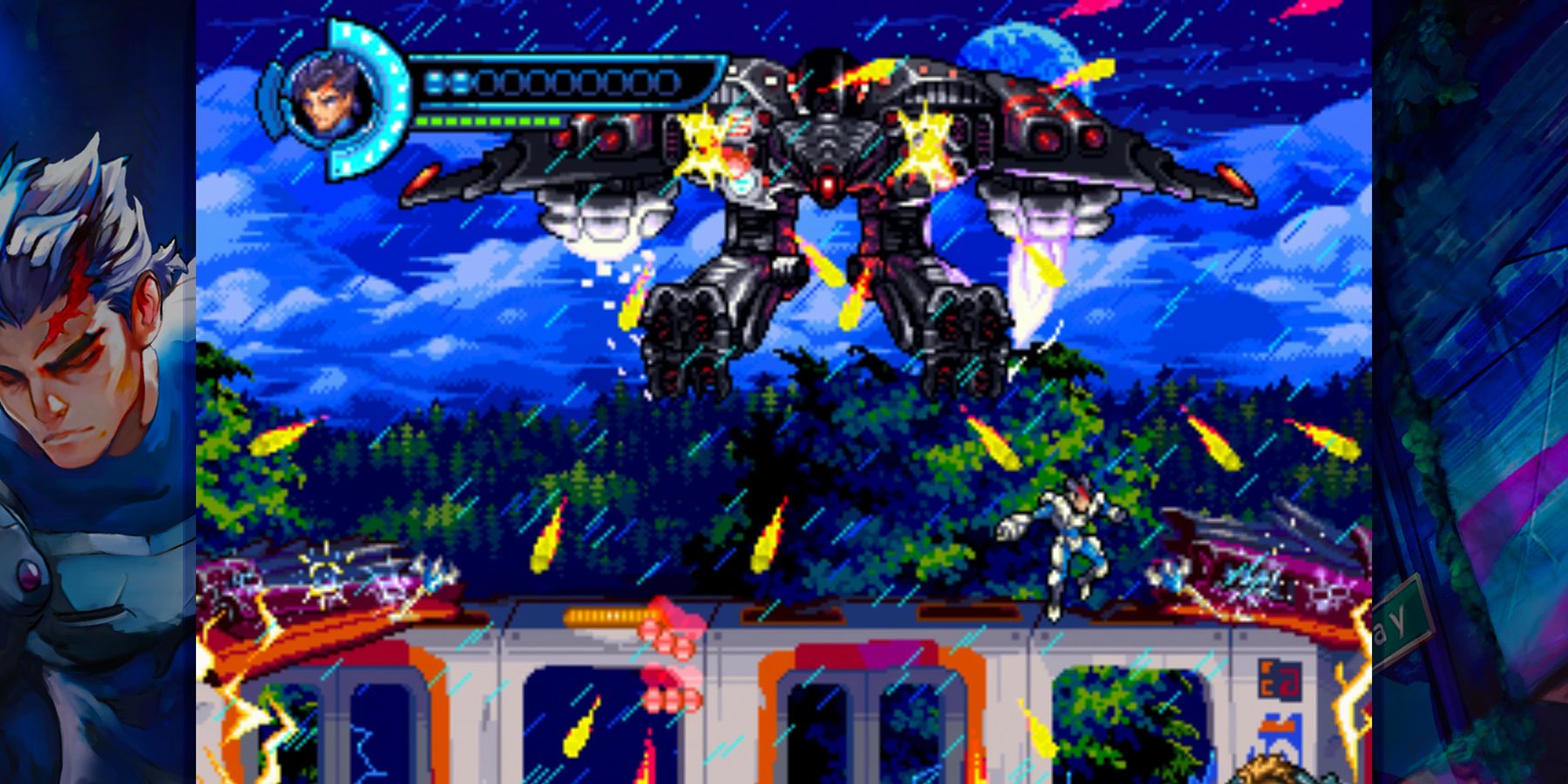Retro-inspired pixel art games have become a common way for developers to introduce themselves to the world, as is the case with Zenovia Interactive's Steel Assault. As first efforts go, Steel Assault suggests Zenovia is a studio to keep an eye on, delivering a mix of frenetic action, synthrock soundtracks, and a refreshingly vibrant post-apocalyptic aesthetic. The sidescrolling indie game launched in September 2021 and hit the ground running, currently boasting a "Very Positive" rating on Steam and a 79 for the PC port on Metacritic.
One of Steel Assault's strengths is the broad range of influences Zenovia Interactive has incorporated. Game Rant spoke to lead developer Sri Kankanahalli about Steel Assault's unique movement mechanics, with inspiration spanning classic arcade titles to Tim Burton's Batman. Kankanahalli also talked about the design principles and inspirations behind the game's pixel art aesthetic and dual soundtracks, which offer very different ways to enjoy the energy whip-cracking arcade adventure.
RELATED: 6 Things We Wish We Knew Before Starting Steel Assault
Pixel Art's Natural Habitat
One of Steel Assault's selling points is its distinctive look, which is reminiscent of the Contra franchise and Mega Man X, designed to simulate the CRT monitors that dominated living rooms and arcades in the 16-bit era. It is far from the first title to feature such a presentation, and these filters are not terribly complex from a technical standpoint. Kankanahalli acknowledges there is no difference between designing pixel art and using graphics to simulate a CRT monitor, but the prior goes a long way toward simulating the arcade era that inspired the title.
"When it comes to pixel art and all the techniques associated with it, like dithering and color bending and so on...they were originally designed for CRT monitors, and those techniques are still in use today. So designing pixel art for a simulated CRT is just the same as designing pixel art, in my view."
Kankanahalli said certain modern games might benefit from using CRT filters to draw out qualities that would normally be lost in translation to modern screens. CRTs are 2D video game sprites' native habitat; the environment that gave rise to them. Steel Assault also uses the same aspect ratio as those older screens, which is a nice thematic touch that evokes the era which inspired it. As other indie developers have noted, retro games are not competing with the games that inspired them, rather the memories players have of those games.
Keeping Steel Assault Cohesive

Steel Assault was an international production that used a team of pixel artists to produce the game's sprites and backgrounds. The game's artists included the Italy-based Walter Samperi, Spain-based Raul Vivar, and Texas-based Eric Quiroz. Samperi's credits include the retro-inspired sidescroller Xydonia, building upon classic Japanese shmups like R-Type and Gradius. Meanwhile, Vivar worked on The Game Kitchen's gory Souls-like metroidvania Blasphemous, which has proven itself a bonefied indie hit.
While collaboration is an inherent part of game development, ideally, the same team of artists will work on a game from start to finish. However, the impact of the COVID-19 pandemic, ancillary professional commitments, and other realities of freelancing caused the team to rotate throughout the game's production. Kankanahalli said maintaining a sense of artistic continuity was not trivial.
"[T]he greatest challenge was maintaining a cohesive style and art direction throughout the entire process. Art was definitely the biggest challenge by far."
RELATED: The 4 Best Things About Steel Assault (& The 4 Worst)
Trying to maintain a focused style with a rotating team of artists adds an extra dimension of complexity to artistic development, as artists must complete their predecessors' unfinished projects, or tailor their personal styles to blend with completed work. Steel Assault's cohessive style is a testament to Zenovia Interactive's management and art direction.
A Tale of Two Soundtracks

Another way Steel Assault goes above and beyond in its quest to appeal to both modern gamers and retro-purists is with its soundtracks. Classic arcade titles depended on stellar scores to keep gamers' blood pumping, and Zenovia decided to develop two complete soundtracks for the game.
London-based composer Joseph "Qwesta" Bailey took the lead on the game's primary synthrock soundtrack. Kankanahalli said Bailey did the soundtrack for Devil Engine, which he considers to be one of the "finest shooters released in recent memory." For Steel Assault, Bailey drew inspiration from Japanese shooting franchises like Thunder Force, which was renowned in its 1980s heyday for its energetic soundtracks composed by Tsukumo Hyakutaro.
The game's second sountrack was an exercise in 16-bit authenticity. In addition to assisting Bailey with some songs from the main soundtrack, Luke McQueen composed an arranged version of Steel Assault's score designed to sound like it came from a Sega Genesis chipset. His influences included classic arcade titles, especially Yuzo Koshiro's work on the Streets of Rage franchise. Players looking for a more immersive trip down memory lane can enable this secondary soundtrack in the game's option menu.
Steel Assault is available now for PC and Switch.
MORE: Interview: Developer Tako Boy Aims to Subvert Expectations with Card Battler/RPG Cross Blitz

